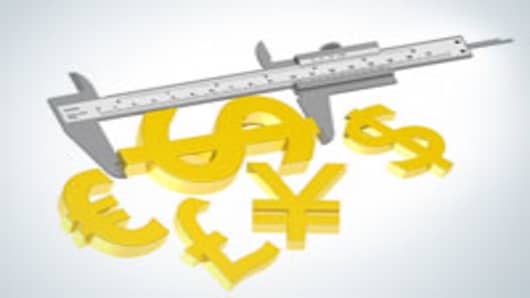Investors are likely to continue using cheap dollars to buy higher-risk assets in the early part of 2010, but with a potentially sharp price to pay down the road.
The so-called "carry trade," in which deep-pocketed investors borrow low-interest US currency to buy higher-yielding assets like stocks and commodities, helped carry the stock market to more than 20 percent gains through 2009.
Absent a drastic change in Fed policy, the trend is likely to continue for the first half of 2010—regardless of what could happen once interest rates rise and the trade unwinds.
"The dollar is going to stay on the funding side of the carry trade equation, and carry is going to perform well as an FX strategy because risk appetite will be reasonably healthy," said Dan Katzive, currency strategist at Credit Suisse in New York. "We will get more concerned when we see valuation extremes."
Many analysts are arguing that stocks remain reasonably valued despite the 60 percent bounce off the March 2009 lows.
Yet there also remains concern that the Federal Reserve at some point this year will have to start raising interest rates to control growth and support the dollar.
The fed funds rate is at an historic low of 0.14 percent, meaning it costs almost nothing for banks to borrow money, and then can lend it out at a high premium. At the same time, the dollar has perked up a bit lately but still remains low compared to other major currencies.
The Japanese yen had historically been the vehicle of choice for the international carry trade but was replaced last year when the dollar tumbled as policymakers sought to prop up the ailing US economy with low interest rates.
When the Fed steps in and starts raising rates again—fed fund futures are indicating the central bank will start tightening this summer—the dollar is likely to strengthen and begin taking the lustre off the carry trade.
The worry is that investors who bought during the dollar carry trade's run will start selling to cover their positions.
"The dollar carry trade has moved from being the layup trade in the second half of last year to being a much riskier proposition," said Nick Colas, chief market strategist at ConvergEx Group in New York. "It may still work out but it's predicated on a series of assumptions that are no longer consensus."
Paramount among the changing dynamics is an economy growing, albeit at an uncertain pace. Most analysts are putting 2010 growth in the 3 percent range, but further injections of government stimulus money not used in 2009 could accelerate things.
At that point the Fed will have no choice but to move in, and stock investors will face a less certain future. And the central bank could even be taken out of the equation somewhat if Treasury auctions start to meet resistance and the government is forced to raise yields to attract buyers.
Colas said he expects the stock market to see double-digit percentage gains in the first half of the year but to stabilize once the dollar starts to strengthen.
Others take a dimmer view of the cheap dollar strategy's demise.
"As they unwind the carry trade, you're going to have excess volatility that's going to have to bleed out, and it's going to bleed out over multiple asset classes," said Todd Hanson, head of forex trading at Team Trading. "I see a lot of retail investors getting stomped on and a lot of options players making out like bandits."
Institutional investors who can borrow large sums of cash drive the carry trade. Retail investors reap secondary and tertiary benefits from the fallout as the influx of cash to the market boosts prices.
But sentiment polls and investment metrics indicate that retail investors had been slow to buy into the rally of the past nine months. That trend has changed in recent weeks, with a sharp jump in equity-based mutual funds and strong bullish sentiments from polls such as those conducted by the American Association of Individual Investors.
Some strategists are afraid that the rally could be running out of gas and ready to bite those late to the party.
"I don't think you ever have a gradual unwinding," said Cliff Draughn, president and chief investment officer at Excelsia Investment Advisors in Savannah, Ga. "Selloffs are much quicker than buy-ins. The end for greed is underweighted by the factor of fear. Fear invades your consciousness much quicker than greed does."
The net result, he said, would likely to be a 15 to 20 percent dropoff from current stock levels to a point where the Standard & Poor's 500 could see 870 or so. While that obviously would represent a shock to investors, Draughn does not see the market retesting the lows of last March, primarily because the Fed will face political pressure to ease its way into rate cuts.
"Frankly, I don't see (Fed Chairman) Ben Bernanke stepping in front of the rate yield curve during an election cycle in 2010," he said. "He just won't do it."
Investors should move toward diversification with 70 percent of portfolios directed towards quality—large-cap stocks such as Johnson & Johnson and Wal-Mart and no banks—with 30 percent towards plays on volatility, Draughn said.
Because he sees markets moving higher before the dollar carry aggressively unwinds, ConvergEx's Colas prefers investors to be in exchange-traded funds that capitalize on selected sector moves—among them the SPDR Industrial and SPDR Technology.
Credit Suisse's Katzive said a lower dollar should be a good bet even if the Fed does make a significant move in 2010 on rates.
"The dollar is likely to remain a lower-yielding currency through much of the year. Even if the Fed hikes by 100 basis points this year ... you're going to get the rate at a significant premium to the rest of the G10," he said. "Generically, low yields are good for stocks."





